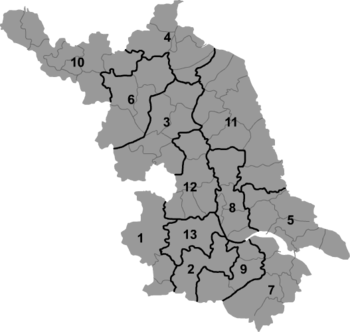Taicang
| Taicang 太仓市 | |
|---|---|
| County-level city | |
 | |
 Taicang Location in Jiangsu | |
| Coordinates: 31°33′50″N 121°10′26″E / 31.564°N 121.174°ECoordinates: 31°33′50″N 121°10′26″E / 31.564°N 121.174°E | |
| Country | People's Republic of China |
| Province | Jiangsu |
| Prefecture-level city | Suzhou |
| Municipal seat | Chengxiang (城厢镇) |
| Divisions | 7 towns: Chengxiang, Shaxi, Ludu, Liuhe, Fuqiao, Huangjing, Shuangfeng |
| Area | |
| • Total | 642 km2 (248 sq mi) |
| Population (2011) | |
| • Total | 947,000 |
| • Density | 1,500/km2 (3,800/sq mi) |
| Time zone | China Standard (UTC+8) |
| Postal code | 215400 |
| Area code(s) | 0512 |
Taicang (Chinese: t 太倉, s 太仓, p Tàicāng, [tʰâi̯ tsʰáŋ], Wu Tha去 Saon平, lit. "Great Storehouse") is a county-level city under the jurisdiction of Suzhou, Jiangsu province, bordering Shanghai to the northeast and east and the Jiangsu prefecture-level city of Nantong to the north across the Yangtze River. In 2008, the registered population was at 466,300, and total GDP reached RMB 52.8 billion (US$7.6 billion). The GDP per capita reached RMB 79,449 (US$11,439). Taicang has been consistently ranked in top 10 of the National Bureau of Statistics' 100 Most Competitive County Level Cities in China.
Administration
Taicang administers seven towns:[1]
- Chengxiang (城厢镇), Shaxi (沙溪镇), Ludu (陆渡镇), Liuhe (浏河镇), Fuqiao (浮桥镇), Huangjing (璜泾镇), Shuangfeng (双凤镇)
History
The city traces its roots back to the 3rd-century Three Kingdoms era, when Eastern Wu build storage facilities for agriculture products in this area.
Taicang is a natural port. Under the Yuan, the city reached its peak between 1271 and 1368. Under the Ming, Taicang's Liuhe Harbor was the departure point for Zheng He's treasure fleets. It was also during this period that the shoals in the Yangtze estuary which later became Chongming Island were placed under the supervision of Taicang Prefecture.[2]
It was the venue for the 2014 IAAF World Race Walking Cup.
Geography
Taicang is centered at 31°30' North and 120°40' East. According to the National Bureau of Statistics, the city has a total area of 318.0 square miles (823.0 km²), of which, 208.0 square miles (537.0 km²) of it is land and 110 square miles (285 km²) of it is water. Yangtze River has 61% of the water area. Taicang is in the Yangtze River Delta Depositional Plain. The whole region is flat, leaning slightly toward southwest. Altitude: 3.5~5.8 meters in east; 2.4~3.8 meters in west.
Taicang port is in the east of the city, and south of the Yangtze exit into the East China sea. The center of Taicang port is in 31°37′00" North, 121°14′00" East. Port line stretches 24.3 miles (38.8 km), of which 15.6 miles can park 50 thousand ton vessels. Taicang is in humid subtropical climate zone with distinctive seasons. Average year round temperate is 15.5 Celsius. Precipitation is around 1078.1 mm.
City awards
- National Ecological City
- National Hygienic City
- National Garden City
- National Longevity City
- National Excellent Tourism City
- National Model City for Environment Protection
- National Advanced City for Public Security
- Service Outsourcing Base City of Jiangsu Province
- Top10 Best Cities for Manufacturing Investors
- Sino-German Business Cooperation City
- The 5th County Level City in Terms of Comprehensive Strength
Demographics
In 2007, the registered population is at 463,800 and the gender ratio is 95. Urban residents compose 62.4% of total population. The racial makeup of the city has 29 ethnic races. Han Chinese is the majority. Among 28 minorities, Hui Chinese and Manchu are the two largest groups.
Famous residents
- Chien-Shiung Wu
- Pioneering physicist from Taicang's Liuhe Township (瀏河). Her father, Zhong-Yi Wu, established Mingde Girl Vocational School in 1913, which is one of the first girls' schools in China. The modern day Mingde School evolved into several schools, covering whole K12 education in Taicang, and it enrolls both genders. Wu left China in 1936 to study physics in United States. She became an American citizen in 1954 and was one of the most well-respected physicists of the 20th century, specializing in the study of atomic physics and radioactivity.[3]
Transportation
Taicang is 60 miles away from Shanghai Pudong International Airport, and even closer to Shanghai Hongqiao International Airport.
There is no railway in Taicang: the closest train stations being in the nearby Kunshan (Kunshan South Railway Station on the Beijing–Shanghai High-Speed Railway and the Shanghai-Nanjing Intercity Railway, and Kunshan Railway Station on the Beijing–Shanghai Railway) or in Shanghai's Jiading District (Anting North Railway Station). However, plans exist for a cross-river railway from Nantong to the Shanghai metropolitan area (the Shanghai–Nantong Railway), which will directly serve Taicang. Construction work was expected to start in 2013 and to take five and a half years.[4]
Friendship cities
-
 Aoya, Japan
Aoya, Japan -
 Malindi, Kenya
Malindi, Kenya -
 Rosolina, Italy
Rosolina, Italy -
 Surrey, British Columbia, Canada
Surrey, British Columbia, Canada -
 Wirral, United Kingdom
Wirral, United Kingdom -
 Sandy Springs, Georgia, United States (pending)
Sandy Springs, Georgia, United States (pending)
See also
External links
- Taicang guide on www.Jiangsu.net (English)
References
- ↑ 2011年统计用区划代码和城乡划分代码:太仓市 (in Chinese). National Bureau of Statistics of the People's Republic of China. Retrieved 2013-06-03.
- ↑ "Chongming County" in the Encyclopedia of Shanghai, pp. 50 ff. Shanghai Scientific & Technical Publishers (Shanghai), 2010. Hosted by the Municipality of Shanghai.
- ↑ McGrayne, Sharon Bertsch (1998). Nobel Prize Women in Science : Their Lives, Struggles, and Momentous Discoveries (Rev. ed.). Washington, D.C.: Joseph Henry Press. p. 54. ISBN 0-309-07270-0.
- ↑ 沪通铁路2013年正式开建 南通到上海仅需一小时 (Construction work on the Hu-Tong Railway will start in 2013. It will take just an hour to travel from Nantong to Shanghai), 2012-12-24, (Chinese)